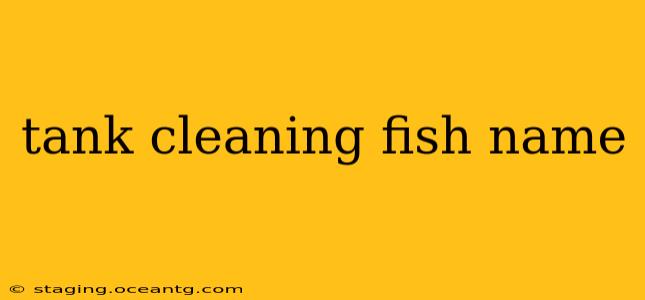Keeping a clean aquarium is crucial for the health and well-being of your fish. While regular water changes are essential, incorporating a dedicated tank cleaning crew can significantly improve water quality and reduce the workload for aquarists. Many fish species play a vital role in maintaining a pristine tank environment. Choosing the right species depends on your tank size, existing inhabitants, and personal preferences. This guide explores some of the best tank cleaning fish and helps you select the ideal candidates for your aquarium.
What are the best tank cleaning fish?
The "best" tank cleaning fish depends entirely on your specific tank setup and existing inhabitants. However, some consistently excellent choices include:
-
Otocinclus Catfish (Otocinclus affinis): These tiny, peaceful catfish are algae-eating machines. They excel at cleaning algae from surfaces like glass, plants, and decorations. However, they are sensitive to water parameters and require established tanks with good water quality.
-
Siamese Algae Eaters (SAE): These active fish effectively control hair algae and other types of algae. Unlike some algae eaters, SAEs generally won't bother other fish. However, they can become picky eaters as they mature, potentially losing interest in algae.
-
Amano Shrimp (Caridina multidentata): These industrious shrimp are incredibly efficient algae scavengers, consuming a wide variety of algae types. They are peaceful and compatible with most fish. They also help keep the substrate clean.
-
Nerite Snails: These snails are excellent algae eaters and are incredibly low-maintenance. They're very effective at cleaning algae from surfaces, and their waste is minimal. They are not suited to tanks with very soft or acidic water.
-
Mystery Snails: While not exclusively algae eaters, Mystery Snails contribute to tank cleanliness by consuming leftover food and decaying organic matter. They're relatively large and can help maintain a cleaner substrate.
What fish clean the bottom of the tank?
Several fish species are adept at cleaning the bottom of the tank, scavenging for uneaten food and waste. These bottom feeders contribute significantly to maintaining a clean substrate:
-
Corydoras Catfish: These peaceful, schooling catfish are popular for their bottom-dwelling habits. They effectively scavenge for leftover food and waste particles, keeping the substrate clean. Different Corydoras species have slightly different requirements, so research the specific needs of your chosen species.
-
Plecostomus (Plecostomus spp.): While many Plecostomus varieties are popular, it's crucial to understand their size. Some species grow extremely large, unsuitable for smaller aquariums. Smaller, more manageable Plecostomus varieties can effectively clean algae and debris from surfaces and the bottom. Ensure you understand the growth potential of the species before introducing one to your tank.
What size tank do I need for cleaning fish?
The tank size required depends entirely on the species of cleaning fish you choose. Small species like Otocinclus catfish need smaller tanks, whereas larger species like certain Plecostomus require significantly larger aquariums to thrive. Always research the specific needs of each species before introducing it to your tank. Overcrowding can negatively impact both the cleaning fish and your other aquarium inhabitants.
Are there any risks associated with using tank cleaning fish?
While generally beneficial, using tank cleaning fish does carry some potential risks:
- Overpopulation: Introducing too many cleaning fish can lead to competition for resources and potentially negatively impact water quality.
- Species incompatibility: Ensure that the cleaning fish you choose are compatible with your existing tank inhabitants.
- Disease: Introducing new fish can potentially introduce diseases into your aquarium. Quarantine new fish before adding them to your main tank.
How many cleaning fish should I have?
The number of cleaning fish needed depends on factors like tank size, bioload, and the type of algae or debris you're trying to control. It's generally best to start with a smaller number and observe their effectiveness before adding more. Overstocking cleaning fish can be detrimental to water quality.
By carefully considering your tank setup, existing inhabitants, and the specific needs of various cleaning fish species, you can create a thriving, naturally clean aquarium. Remember to always research thoroughly and prioritize the well-being of all your aquatic companions.
